© 2008. Not to be used without

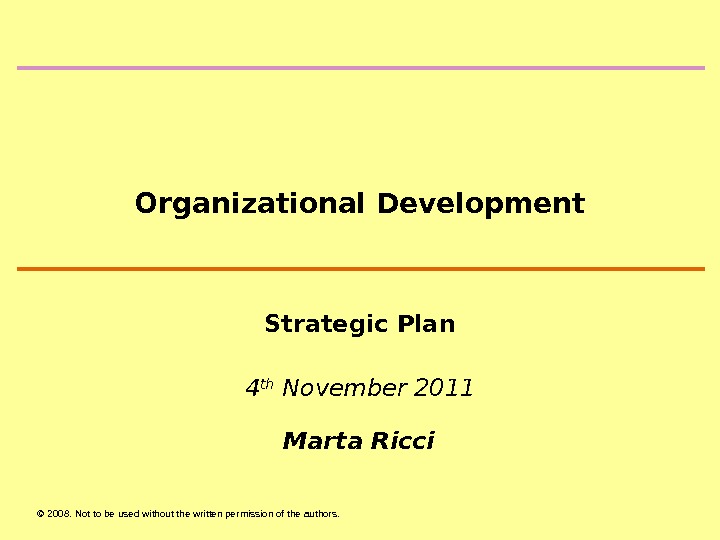
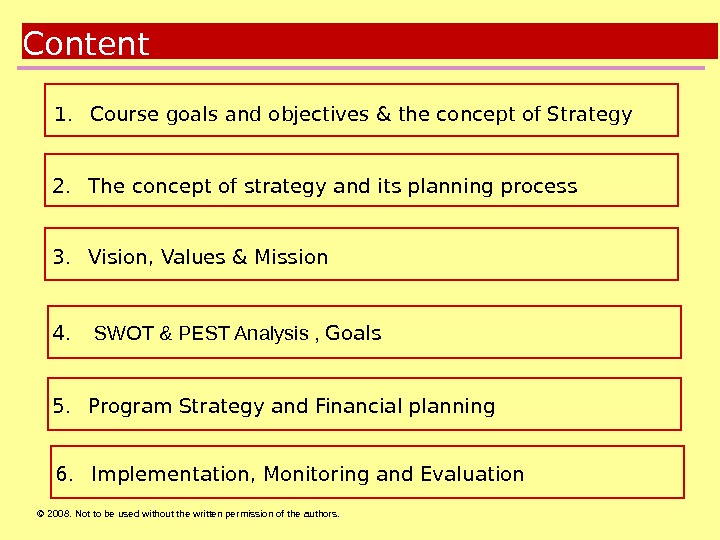
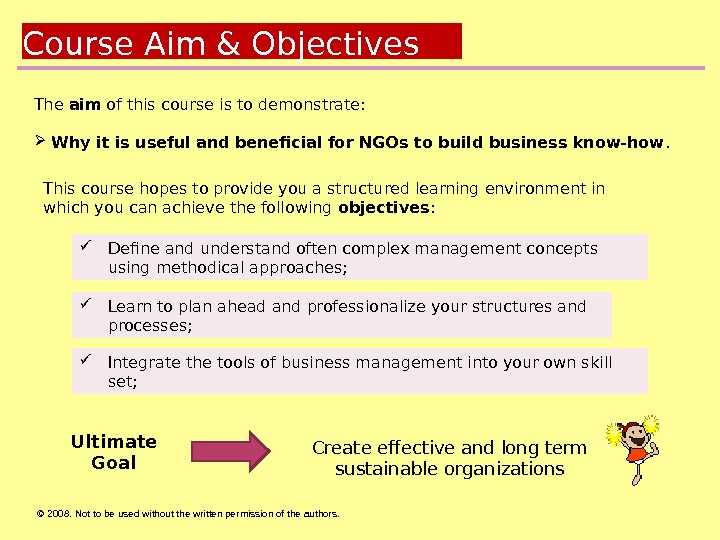
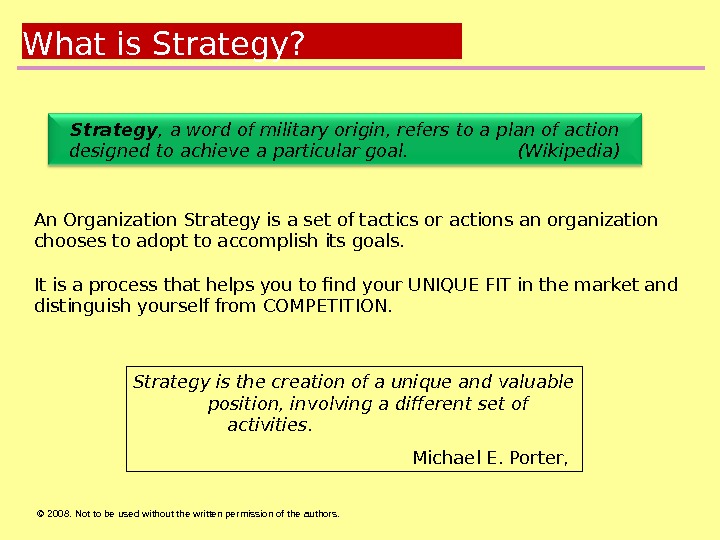
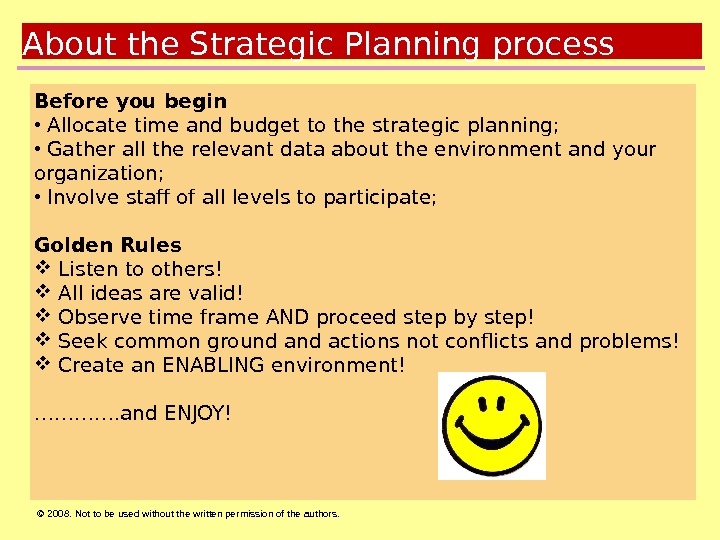
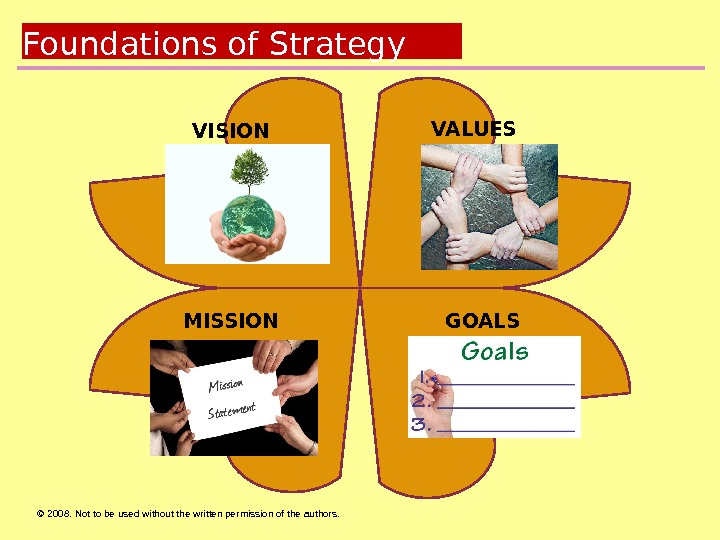
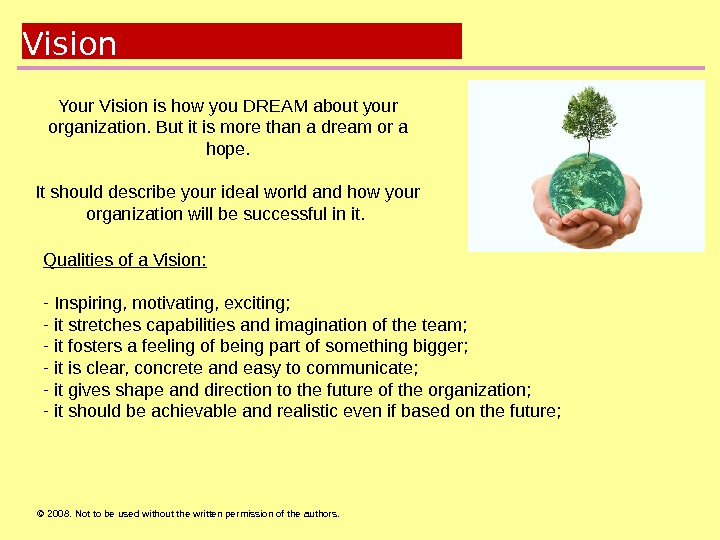
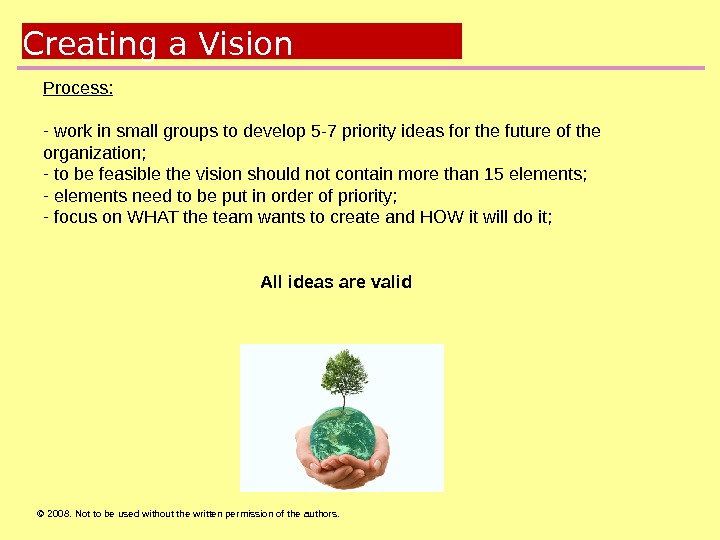
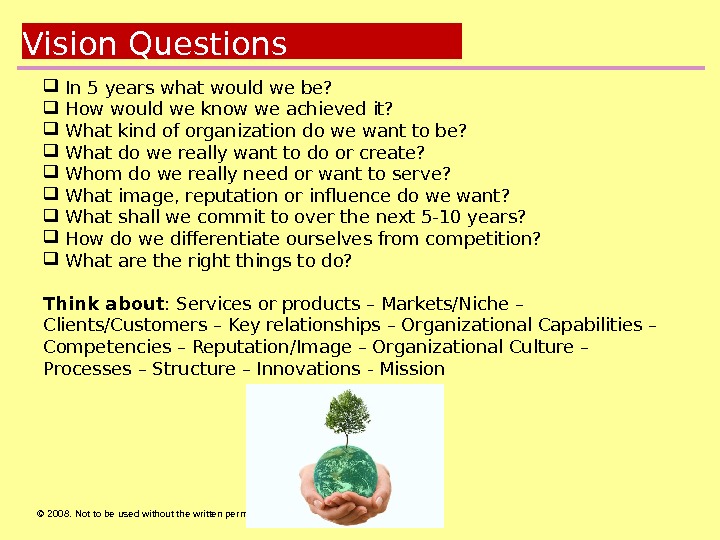
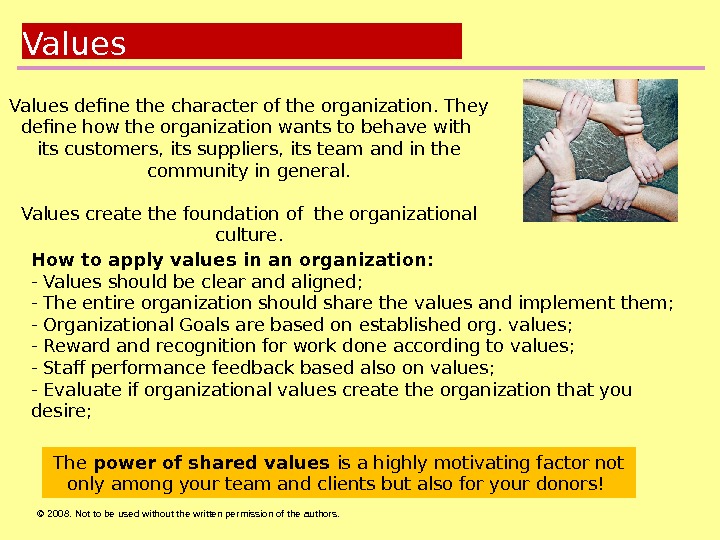
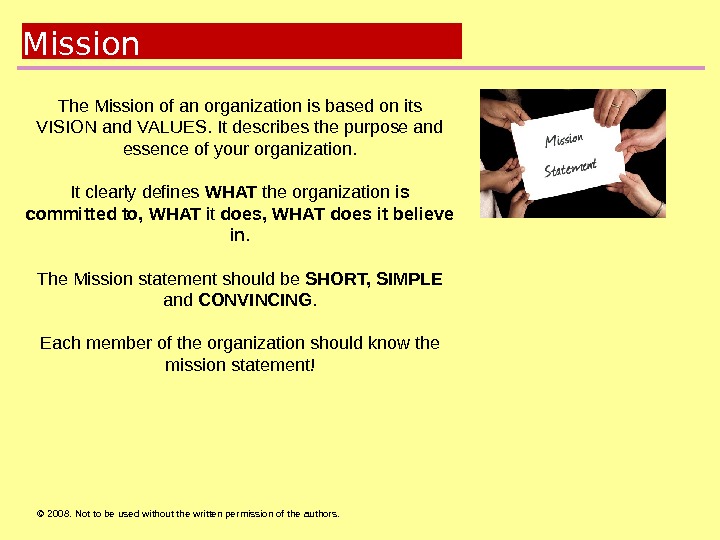
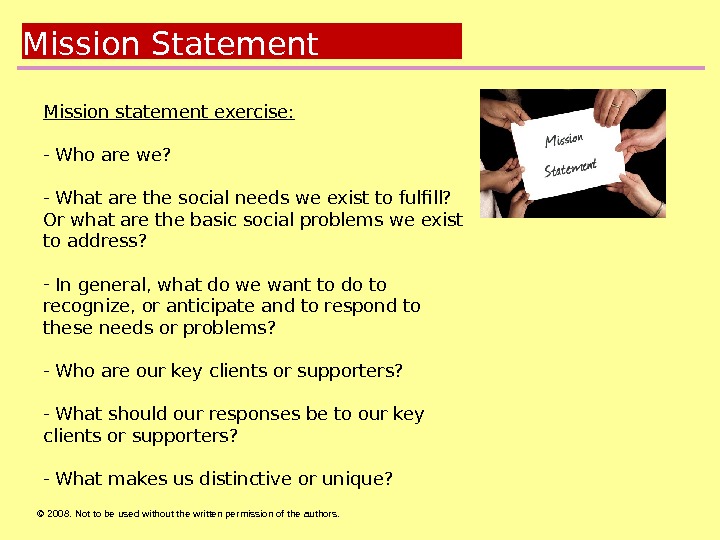
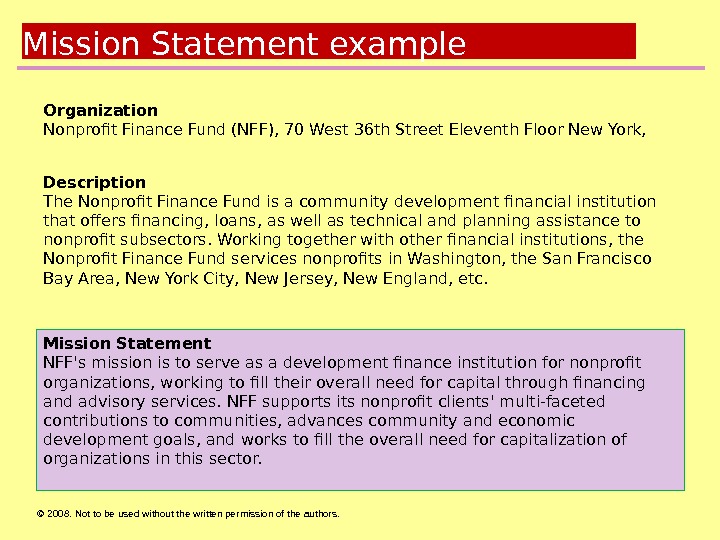
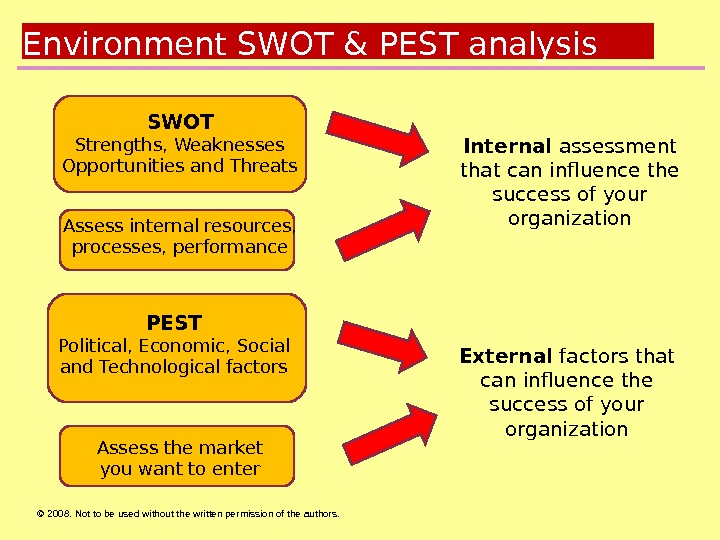
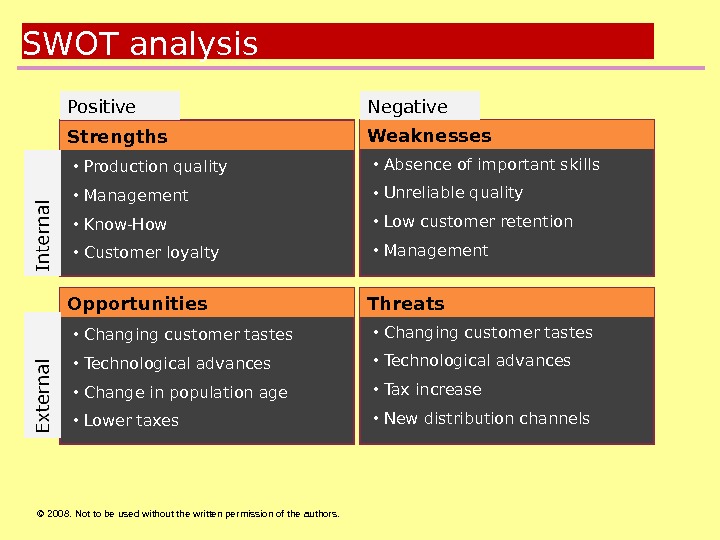
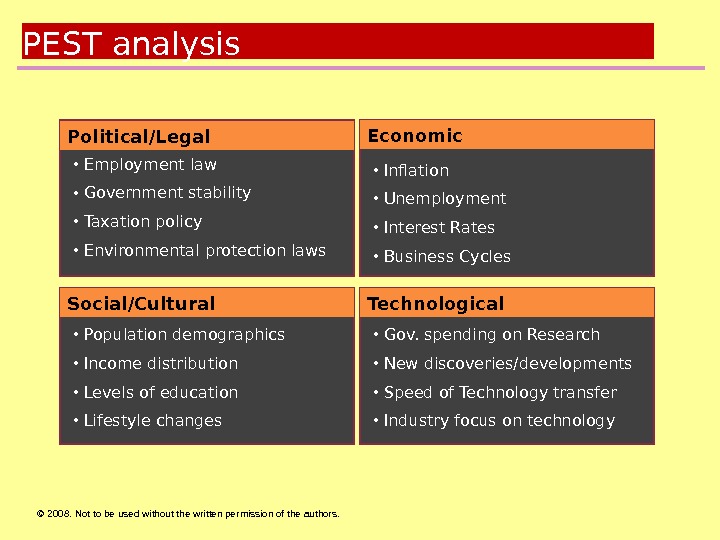
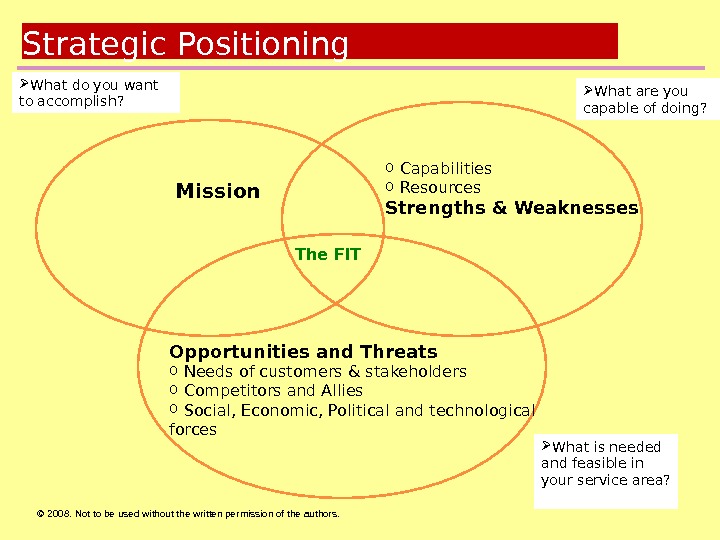
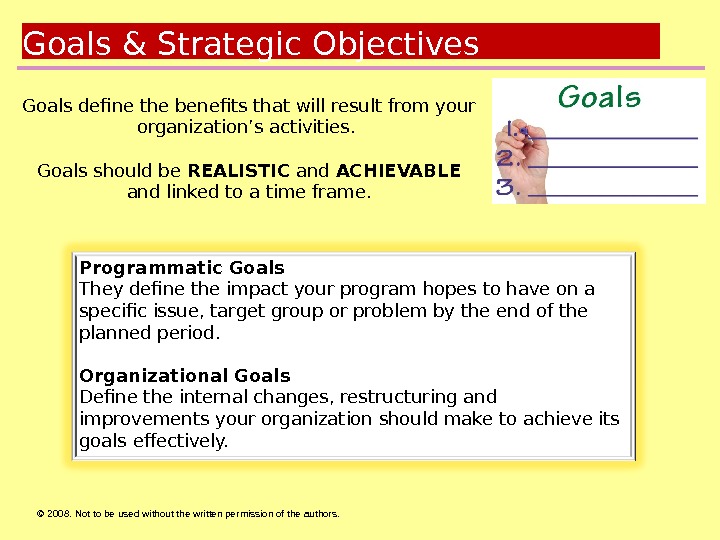
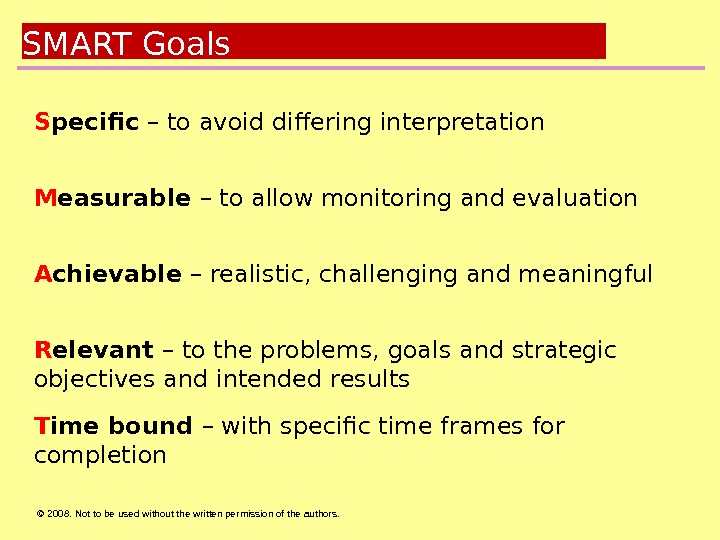
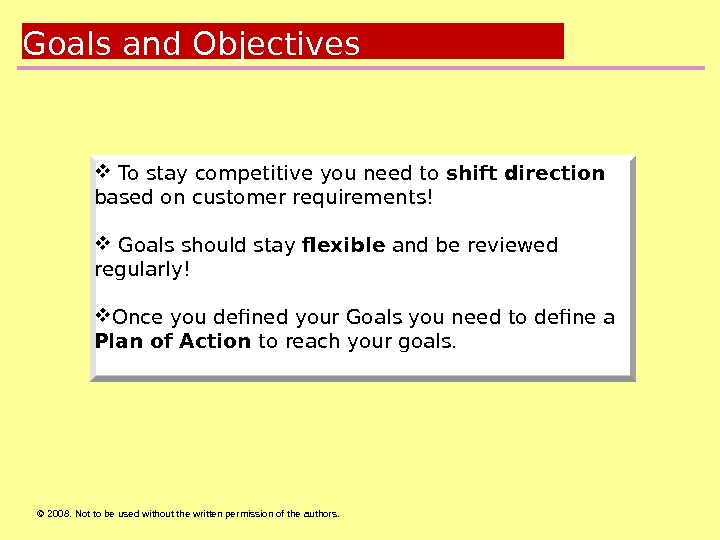
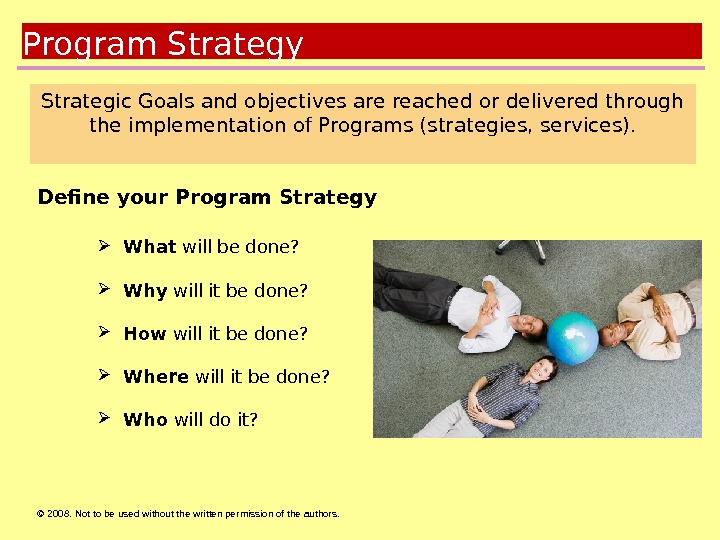
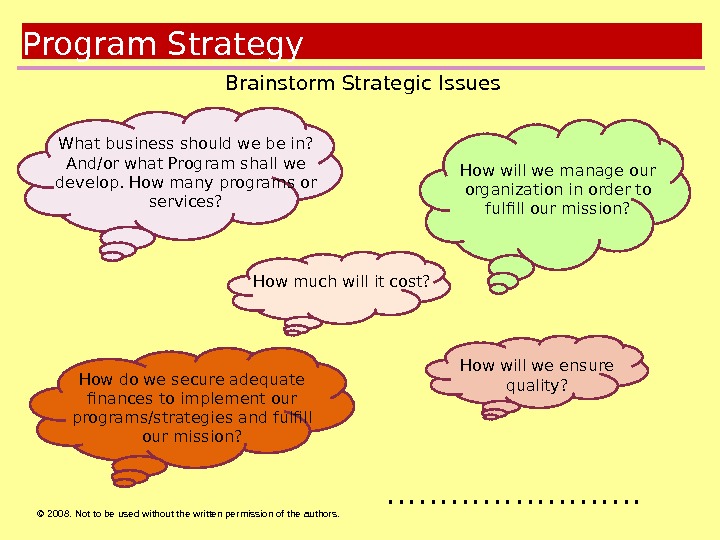
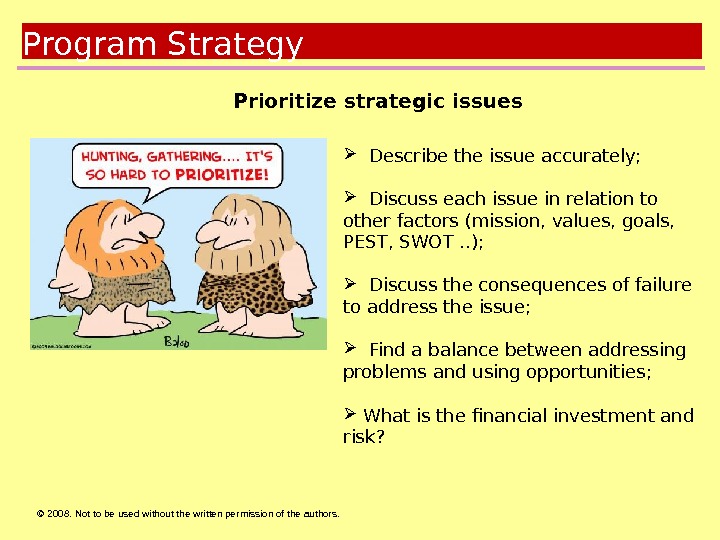
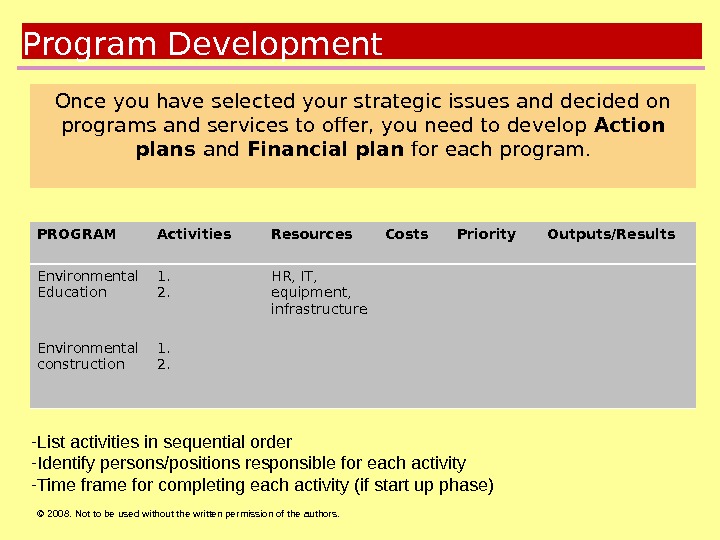
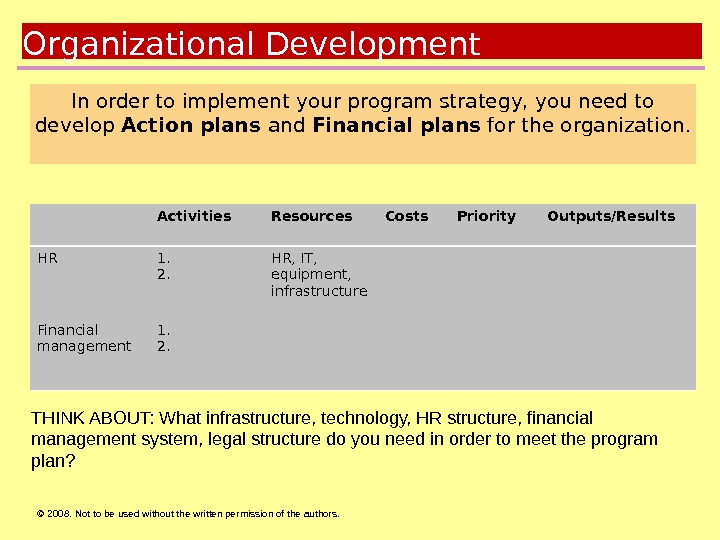
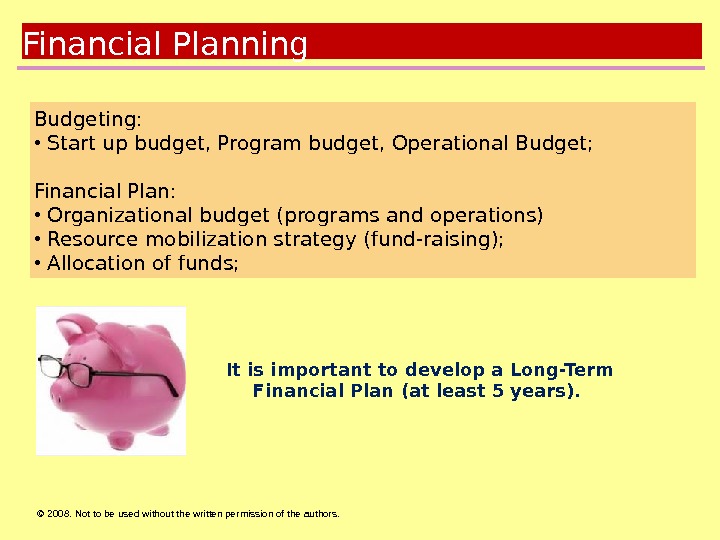
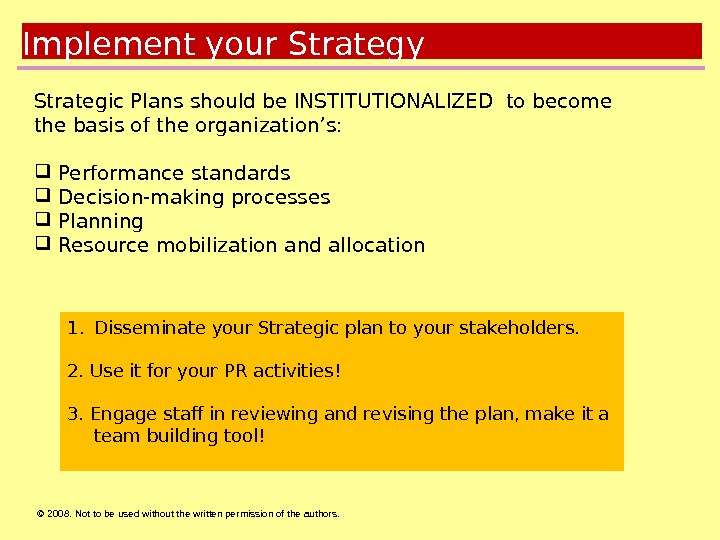
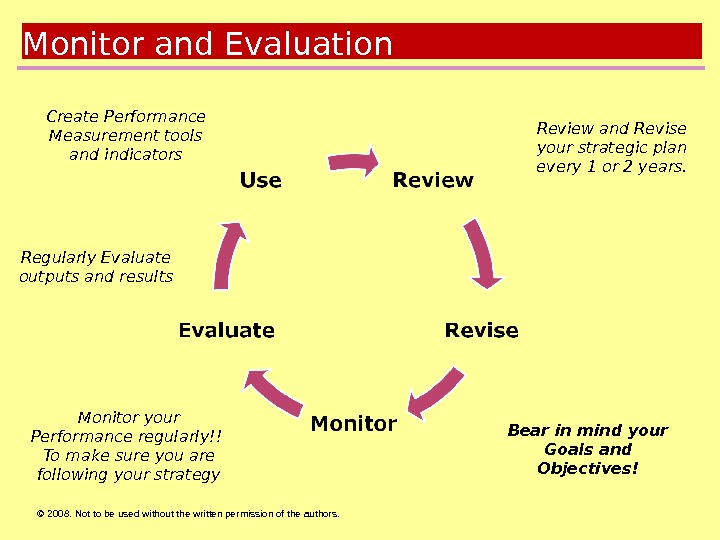
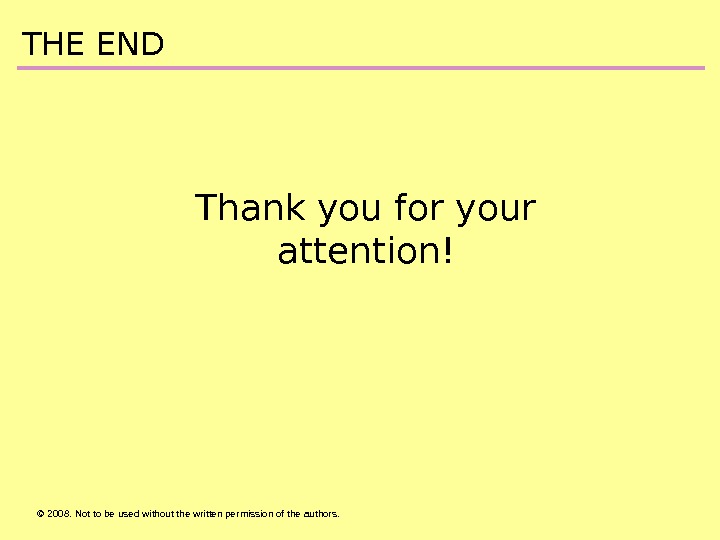
- Размер: 1.1 Mегабайта
- Количество слайдов: 29
Описание презентации © 2008. Not to be used without по слайдам
 © 2008. Not to be used without the written permission of the authors. Organizational Development Strategic Plan 4 th November 2011 Marta Ricci
© 2008. Not to be used without the written permission of the authors. Organizational Development Strategic Plan 4 th November 2011 Marta Ricci
 © 2008. Not to be used without the written permission of the authors. 2. The concept of strategy and its planning process 4. SWOT & PEST Analysis , Goals 3. Vision, Values & Mission Content 1. Course goals and objectives & the concept of Strategy 5. Program Strategy and Financial planning 6. Implementation, Monitoring and Evaluation
© 2008. Not to be used without the written permission of the authors. 2. The concept of strategy and its planning process 4. SWOT & PEST Analysis , Goals 3. Vision, Values & Mission Content 1. Course goals and objectives & the concept of Strategy 5. Program Strategy and Financial planning 6. Implementation, Monitoring and Evaluation
 © 2008. Not to be used without the written permission of the authors. Course Aim & Objectives This course hopes to provide you a structured learning environment in which you can achieve the following objectives : The aim of this course is to demonstrate: Why it is useful and beneficial for NGOs to build business know-how. Define and understand often complex management concepts using methodical approaches; Learn to plan ahead and professionalize your structures and processes; Integrate the tools of business management into your own skill set; Ultimate Goal Create effective and long term sustainable organizations
© 2008. Not to be used without the written permission of the authors. Course Aim & Objectives This course hopes to provide you a structured learning environment in which you can achieve the following objectives : The aim of this course is to demonstrate: Why it is useful and beneficial for NGOs to build business know-how. Define and understand often complex management concepts using methodical approaches; Learn to plan ahead and professionalize your structures and processes; Integrate the tools of business management into your own skill set; Ultimate Goal Create effective and long term sustainable organizations
 © 2008. Not to be used without the written permission of the authors. What is Strategy? An Organization Strategy is a set of tactics or actions an organization chooses to adopt to accomplish its goals. It is a process that helps you to find your UNIQUE FIT in the market and distinguish yourself from COMPETITION. Strategy is the creation of a unique and valuable position, involving a different set of activities. Michael E. Porter, Strategy , a word ofmilitaryorigin, refers to aplanof action designed to achieve a particulargoal. (Wikipedia)
© 2008. Not to be used without the written permission of the authors. What is Strategy? An Organization Strategy is a set of tactics or actions an organization chooses to adopt to accomplish its goals. It is a process that helps you to find your UNIQUE FIT in the market and distinguish yourself from COMPETITION. Strategy is the creation of a unique and valuable position, involving a different set of activities. Michael E. Porter, Strategy , a word ofmilitaryorigin, refers to aplanof action designed to achieve a particulargoal. (Wikipedia)
 © 2008. Not to be used without the written permission of the authors. Goals. About the Strategic Planning process Before you begin • Allocate time and budget to the strategic planning; • Gather all the relevant data about the environment and your organization; • Involve staff of all levels to participate; Golden Rules Listen to others! All ideas are valid! Observe time frame AND proceed step by step! Seek common ground actions not conflicts and problems! Create an ENABLING environment! …………. and ENJOY!
© 2008. Not to be used without the written permission of the authors. Goals. About the Strategic Planning process Before you begin • Allocate time and budget to the strategic planning; • Gather all the relevant data about the environment and your organization; • Involve staff of all levels to participate; Golden Rules Listen to others! All ideas are valid! Observe time frame AND proceed step by step! Seek common ground actions not conflicts and problems! Create an ENABLING environment! …………. and ENJOY!
 © 2008. Not to be used without the written permission of the authors. Foundations of Strategy VISION MISSION VALUES GOALS
© 2008. Not to be used without the written permission of the authors. Foundations of Strategy VISION MISSION VALUES GOALS
 © 2008. Not to be used without the written permission of the authors. Vision Your Vision is how you DREAM about your organization. But it is more than a dream or a hope. It should describe your ideal world and how your organization will be successful in it. Qualities of a Vision: — Inspiring, motivating, exciting; — it stretches capabilities and imagination of the team; — it fosters a feeling of being part of something bigger; — it is clear, concrete and easy to communicate; — it gives shape and direction to the future of the organization; — it should be achievable and realistic even if based on the future;
© 2008. Not to be used without the written permission of the authors. Vision Your Vision is how you DREAM about your organization. But it is more than a dream or a hope. It should describe your ideal world and how your organization will be successful in it. Qualities of a Vision: — Inspiring, motivating, exciting; — it stretches capabilities and imagination of the team; — it fosters a feeling of being part of something bigger; — it is clear, concrete and easy to communicate; — it gives shape and direction to the future of the organization; — it should be achievable and realistic even if based on the future;
 © 2008. Not to be used without the written permission of the authors. Creating a Vision Process: — work in small groups to develop 5 -7 priority ideas for the future of the organization; — to be feasible the vision should not contain more than 15 elements; — elements need to be put in order of priority; — focus on WHAT the team wants to create and HOW it will do it; All ideas are valid
© 2008. Not to be used without the written permission of the authors. Creating a Vision Process: — work in small groups to develop 5 -7 priority ideas for the future of the organization; — to be feasible the vision should not contain more than 15 elements; — elements need to be put in order of priority; — focus on WHAT the team wants to create and HOW it will do it; All ideas are valid
 © 2008. Not to be used without the written permission of the authors. Vision Questions In 5 years what would we be? How would we know we achieved it? What kind of organization do we want to be? What do we really want to do or create? Whom do we really need or want to serve? What image, reputation or influence do we want? What shall we commit to over the next 5 -10 years? How do we differentiate ourselves from competition? What are the right things to do? Think about : Services or products – Markets/Niche – Clients/Customers – Key relationships – Organizational Capabilities – Competencies – Reputation/Image – Organizational Culture – Processes – Structure – Innovations — Mission
© 2008. Not to be used without the written permission of the authors. Vision Questions In 5 years what would we be? How would we know we achieved it? What kind of organization do we want to be? What do we really want to do or create? Whom do we really need or want to serve? What image, reputation or influence do we want? What shall we commit to over the next 5 -10 years? How do we differentiate ourselves from competition? What are the right things to do? Think about : Services or products – Markets/Niche – Clients/Customers – Key relationships – Organizational Capabilities – Competencies – Reputation/Image – Organizational Culture – Processes – Structure – Innovations — Mission
 © 2008. Not to be used without the written permission of the authors. Values define the character of the organization. They define how the organization wants to behave with its customers, its suppliers, its team and in the community in general. Values create the foundation of the organizational culture. How to apply values in an organization: — Values should be clear and aligned; — The entire organization should share the values and implement them; — Organizational Goals are based on established org. values; — Reward and recognition for work done according to values; — Staff performance feedback based also on values; — Evaluate if organizational values create the organization that you desire; The power of shared values is a highly motivating factor not only among your team and clients but also for your donors!
© 2008. Not to be used without the written permission of the authors. Values define the character of the organization. They define how the organization wants to behave with its customers, its suppliers, its team and in the community in general. Values create the foundation of the organizational culture. How to apply values in an organization: — Values should be clear and aligned; — The entire organization should share the values and implement them; — Organizational Goals are based on established org. values; — Reward and recognition for work done according to values; — Staff performance feedback based also on values; — Evaluate if organizational values create the organization that you desire; The power of shared values is a highly motivating factor not only among your team and clients but also for your donors!
 © 2008. Not to be used without the written permission of the authors. Mission The Mission of an organization is based on its VISION and VALUES. It describes the purpose and essence of your organization. It clearly defines WHAT the organization is committed to, WHAT it does, WHAT does it believe in. The Mission statement should be SHORT, SIMPLE and CONVINCING. Each member of the organization should know the mission statement!
© 2008. Not to be used without the written permission of the authors. Mission The Mission of an organization is based on its VISION and VALUES. It describes the purpose and essence of your organization. It clearly defines WHAT the organization is committed to, WHAT it does, WHAT does it believe in. The Mission statement should be SHORT, SIMPLE and CONVINCING. Each member of the organization should know the mission statement!
 © 2008. Not to be used without the written permission of the authors. Mission Statement Mission statement exercise: — Who are we? — What are the social needs we exist to fulfill? Or what are the basic social problems we exist to address? — In general, what do we want to do to recognize, or anticipate and to respond to these needs or problems? — Who are our key clients or supporters? — What should our responses be to our key clients or supporters? — What makes us distinctive or unique?
© 2008. Not to be used without the written permission of the authors. Mission Statement Mission statement exercise: — Who are we? — What are the social needs we exist to fulfill? Or what are the basic social problems we exist to address? — In general, what do we want to do to recognize, or anticipate and to respond to these needs or problems? — Who are our key clients or supporters? — What should our responses be to our key clients or supporters? — What makes us distinctive or unique?
 © 2008. Not to be used without the written permission of the authors. Mission Statement example Mission Statement NFF’s mission is to serve as a development finance institution for nonprofit organizations, working to fill their overall need for capital through financing and advisory services. NFF supports its nonprofit clients’ multi-faceted contributions to communities, advances community and economic development goals, and works to fill the overall need for capitalization of organizations in this sector. Organization Nonprofit Finance Fund (NFF), 70 West 36 th Street Eleventh Floor New York, Description The Nonprofit Finance Fund is a community development financial institution that offers financing, loans, as well as technical and planning assistance to nonprofit subsectors. Working together with other financial institutions, the Nonprofit Finance Fund services nonprofits in Washington, the San Francisco Bay Area, New York City, New Jersey, New England, etc.
© 2008. Not to be used without the written permission of the authors. Mission Statement example Mission Statement NFF’s mission is to serve as a development finance institution for nonprofit organizations, working to fill their overall need for capital through financing and advisory services. NFF supports its nonprofit clients’ multi-faceted contributions to communities, advances community and economic development goals, and works to fill the overall need for capitalization of organizations in this sector. Organization Nonprofit Finance Fund (NFF), 70 West 36 th Street Eleventh Floor New York, Description The Nonprofit Finance Fund is a community development financial institution that offers financing, loans, as well as technical and planning assistance to nonprofit subsectors. Working together with other financial institutions, the Nonprofit Finance Fund services nonprofits in Washington, the San Francisco Bay Area, New York City, New Jersey, New England, etc.
 © 2008. Not to be used without the written permission of the authors. Environment SWOT & PEST analysis Internal assessment that can influence the success of your organization. SWOT Strengths, Weaknesses Opportunities and Threats External factors that can influence the success of your organization. PEST Political, Economic, Social and Technological factors Assess the market you want to enter. Assess internal resources, processes, performance
© 2008. Not to be used without the written permission of the authors. Environment SWOT & PEST analysis Internal assessment that can influence the success of your organization. SWOT Strengths, Weaknesses Opportunities and Threats External factors that can influence the success of your organization. PEST Political, Economic, Social and Technological factors Assess the market you want to enter. Assess internal resources, processes, performance
 © 2008. Not to be used without the written permission of the authors. SWOT analysis Positive Negative Strengths Weaknesses Opportunities Threats • Changing customer tastes • Technological advances • Change in population age • Lower taxes • Changing customer tastes • Technological advances • Tax increase • New distribution channels • Absence of important skills • Unreliable quality • Low customer retention • Management • Production quality • Management • Know-How • Customer loyalty
© 2008. Not to be used without the written permission of the authors. SWOT analysis Positive Negative Strengths Weaknesses Opportunities Threats • Changing customer tastes • Technological advances • Change in population age • Lower taxes • Changing customer tastes • Technological advances • Tax increase • New distribution channels • Absence of important skills • Unreliable quality • Low customer retention • Management • Production quality • Management • Know-How • Customer loyalty
 © 2008. Not to be used without the written permission of the authors. PEST analysis Political/Legal Economic Social/Cultural Technological • Employment law • Government stability • Taxation policy • Environmental protection laws • Inflation • Unemployment • Interest Rates • Business Cycles • Gov. spending on Research • New discoveries/developments • Speed of Technology transfer • Industry focus on technology • Population demographics • Income distribution • Levels of education • Lifestyle changes
© 2008. Not to be used without the written permission of the authors. PEST analysis Political/Legal Economic Social/Cultural Technological • Employment law • Government stability • Taxation policy • Environmental protection laws • Inflation • Unemployment • Interest Rates • Business Cycles • Gov. spending on Research • New discoveries/developments • Speed of Technology transfer • Industry focus on technology • Population demographics • Income distribution • Levels of education • Lifestyle changes
 © 2008. Not to be used without the written permission of the authors. Strategic Positioning The FIT o Capabilities o Resources Strengths & Weaknesses. Mission Opportunities and Threats o Needs of customers & stakeholders o Competitors and Allies o Social, Economic, Political and technological forces What are you capable of doing? What is needed and feasible in your service area? What do you want to accomplish?
© 2008. Not to be used without the written permission of the authors. Strategic Positioning The FIT o Capabilities o Resources Strengths & Weaknesses. Mission Opportunities and Threats o Needs of customers & stakeholders o Competitors and Allies o Social, Economic, Political and technological forces What are you capable of doing? What is needed and feasible in your service area? What do you want to accomplish?
 © 2008. Not to be used without the written permission of the authors. Goals & Strategic Objectives Goals define the benefits that will result from your organization’s activities. Goals should be REALISTIC and ACHIEVABLE and linked to a time frame. Programmatic Goals They define the impact your program hopes to have on a specific issue, target group or problem by the end of the planned period. Organizational Goals Define the internal changes, restructuring and improvements your organization should make to achieve its goals effectively.
© 2008. Not to be used without the written permission of the authors. Goals & Strategic Objectives Goals define the benefits that will result from your organization’s activities. Goals should be REALISTIC and ACHIEVABLE and linked to a time frame. Programmatic Goals They define the impact your program hopes to have on a specific issue, target group or problem by the end of the planned period. Organizational Goals Define the internal changes, restructuring and improvements your organization should make to achieve its goals effectively.
 © 2008. Not to be used without the written permission of the authors. SMART Goals S pecific – to avoid differing interpretation M easurable – to allow monitoring and evaluation A chievable – realistic, challenging and meaningful R elevant – to the problems, goals and strategic objectives and intended results T ime bound – with specific time frames for completion
© 2008. Not to be used without the written permission of the authors. SMART Goals S pecific – to avoid differing interpretation M easurable – to allow monitoring and evaluation A chievable – realistic, challenging and meaningful R elevant – to the problems, goals and strategic objectives and intended results T ime bound – with specific time frames for completion
 © 2008. Not to be used without the written permission of the authors. Goals and Objectives To stay competitive you need to shift direction based on customer requirements! Goals should stay flexible and be reviewed regularly! Once you defined your Goals you need to define a Plan of Action to reach your goals.
© 2008. Not to be used without the written permission of the authors. Goals and Objectives To stay competitive you need to shift direction based on customer requirements! Goals should stay flexible and be reviewed regularly! Once you defined your Goals you need to define a Plan of Action to reach your goals.
 © 2008. Not to be used without the written permission of the authors. Goals Strategic Goals and objectives are reached or delivered through the implementation of Programs (strategies, services). Program Strategy What will be done? Why will it be done? How will it be done? Where will it be done? Who will do it? Define your Program Strategy
© 2008. Not to be used without the written permission of the authors. Goals Strategic Goals and objectives are reached or delivered through the implementation of Programs (strategies, services). Program Strategy What will be done? Why will it be done? How will it be done? Where will it be done? Who will do it? Define your Program Strategy
 © 2008. Not to be used without the written permission of the authors. Goals Brainstorm Strategic Issues Program Strategy How will we ensure quality? What business should we be in? And/or what Program shall we develop. How many programs or services? How much will it cost? How do we secure adequate finances to implement our programs/strategies and fulfill our mission? How will we manage our organization in order to fulfill our mission? …………
© 2008. Not to be used without the written permission of the authors. Goals Brainstorm Strategic Issues Program Strategy How will we ensure quality? What business should we be in? And/or what Program shall we develop. How many programs or services? How much will it cost? How do we secure adequate finances to implement our programs/strategies and fulfill our mission? How will we manage our organization in order to fulfill our mission? …………
 © 2008. Not to be used without the written permission of the authors. Goals. Program Strategy Describe the issue accurately; Discuss each issue in relation to other factors (mission, values, goals, PEST, SWOT. . ); Discuss the consequences of failure to address the issue; Find a balance between addressing problems and using opportunities; What is the financial investment and risk? Prioritize strategic issues
© 2008. Not to be used without the written permission of the authors. Goals. Program Strategy Describe the issue accurately; Discuss each issue in relation to other factors (mission, values, goals, PEST, SWOT. . ); Discuss the consequences of failure to address the issue; Find a balance between addressing problems and using opportunities; What is the financial investment and risk? Prioritize strategic issues
 © 2008. Not to be used without the written permission of the authors. Goals. Program Development Once you have selected your strategic issues and decided on programs and services to offer, you need to develop Action plans and Financial plan for each program. PROGRAM Activities Resources Costs Priority Outputs/Results Environmental Education 1. 2. HR, IT, equipment, infrastructure Environmental construction 1. 2. — List activities in sequential order — Identify persons/positions responsible for each activity — Time frame for completing each activity (if start up phase)
© 2008. Not to be used without the written permission of the authors. Goals. Program Development Once you have selected your strategic issues and decided on programs and services to offer, you need to develop Action plans and Financial plan for each program. PROGRAM Activities Resources Costs Priority Outputs/Results Environmental Education 1. 2. HR, IT, equipment, infrastructure Environmental construction 1. 2. — List activities in sequential order — Identify persons/positions responsible for each activity — Time frame for completing each activity (if start up phase)
 © 2008. Not to be used without the written permission of the authors. Goals. Organizational Development In order to implement your program strategy, you need to develop Action plans and Financial plans for the organization. Activities Resources Costs Priority Outputs/Results HR 1. 2. HR, IT, equipment, infrastructure Financial management 1. 2. THINK ABOUT: What infrastructure, technology, HR structure, financial management system, legal structure do you need in order to meet the program plan?
© 2008. Not to be used without the written permission of the authors. Goals. Organizational Development In order to implement your program strategy, you need to develop Action plans and Financial plans for the organization. Activities Resources Costs Priority Outputs/Results HR 1. 2. HR, IT, equipment, infrastructure Financial management 1. 2. THINK ABOUT: What infrastructure, technology, HR structure, financial management system, legal structure do you need in order to meet the program plan?
 © 2008. Not to be used without the written permission of the authors. Goals. Financial Planning Budgeting: • Start up budget, Program budget, Operational Budget; Financial Plan: • Organizational budget (programs and operations) • Resource mobilization strategy (fund-raising); • Allocation of funds; It is important to develop a Long-Term Financial Plan (at least 5 years).
© 2008. Not to be used without the written permission of the authors. Goals. Financial Planning Budgeting: • Start up budget, Program budget, Operational Budget; Financial Plan: • Organizational budget (programs and operations) • Resource mobilization strategy (fund-raising); • Allocation of funds; It is important to develop a Long-Term Financial Plan (at least 5 years).
 © 2008. Not to be used without the written permission of the authors. Goals. Implement your Strategy Strategic Plans should be INSTITUTIONALIZED to become the basis of the organization’s: Performance standards Decision-making processes Planning Resource mobilization and allocation 1. Disseminate your Strategic plan to your stakeholders. 2. Use it for your PR activities! 3. Engage staff in reviewing and revising the plan, make it a team building tool!
© 2008. Not to be used without the written permission of the authors. Goals. Implement your Strategy Strategic Plans should be INSTITUTIONALIZED to become the basis of the organization’s: Performance standards Decision-making processes Planning Resource mobilization and allocation 1. Disseminate your Strategic plan to your stakeholders. 2. Use it for your PR activities! 3. Engage staff in reviewing and revising the plan, make it a team building tool!
 © 2008. Not to be used without the written permission of the authors. Goals. Monitor and Evaluation Create Performance Measurement tools and indicators Monitor your Performance regularly!! To make sure you are following your strategy Review and Revise your strategic plan every 1 or 2 years. Regularly Evaluate outputs and results Bear in mind your Goals and Objectives!
© 2008. Not to be used without the written permission of the authors. Goals. Monitor and Evaluation Create Performance Measurement tools and indicators Monitor your Performance regularly!! To make sure you are following your strategy Review and Revise your strategic plan every 1 or 2 years. Regularly Evaluate outputs and results Bear in mind your Goals and Objectives!
 © 2008. Not to be used without the written permission of the authors. THE END Thank you for your attention!
© 2008. Not to be used without the written permission of the authors. THE END Thank you for your attention!

